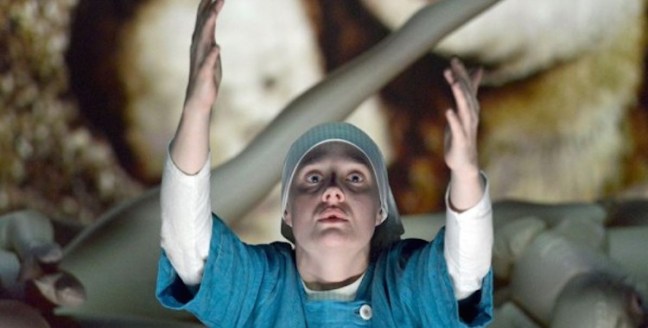Originally written for Exeunt.
From the moment the house lights fall at the Young Vic, there’s no doubting that this Measure for Measure is about sex. The curtains – plastic, wipe-clean – part to reveal a writhing orgy of blow-up dolls, painted mouths stretched wide, from which the cast emerge. At the show’s opening, Vienna is soaked in sin. The tight fist of the law has slackened and the people are running amok. In one sense, Shakespeare’s prickly, problematic play is one long tussle to reinstate discipline and restraint. Trouble is, sex – like those miniature mountains of blow-up dolls – is impossible to ignore or deny.
In Joe Hill-Gibbins’ production, everything about the characters can be read from the way they deal with this tangle of plastic limbs. Zubin Varla’s “old fantastical duke of dark corners”, dishevelled and wide-eyed, proclaims to “love the people” in the same movement as trampling his inflatable citizens underfoot. He wants to restore order, but he doesn’t want to be the one to do it. Instead, he appoints Angelo, a man who “scarce confesses / That his blood flows”. Prim as a village priest, Bible tucked under his arm like a comfort blanket, Paul Ready’s unlikely leader picks his way carefully through the debauchery, careful to at once ignore and avoid it. Revelling subjects, meanwhile, throw the dolls from hand to hand, finding pleasure wherever they can.
Then there’s Isabella. The first time we see her, Romola Garai’s nun-in-training wearily pushes all relics of earthly temptation out of her way, murmuring reverent words of prayer as she does so. No hanky-panky for her, nor seemingly any desire for it. When her brother Claudio (Ivanno Jeremiah) is to be executed as an example – his pre-marital sexual exploits here caught on tape in a sly nod to surveillance culture – she finds her voice, making a persuasive petition to Angelo. Garai’s Isabella might be forbiddingly austere, but she’s also steely and impassioned, positively spitting out the words “man, proud man”. Although she’s trapped in what is still, for all the modern dress, overwhelmingly a man’s world, she is not a woman to underestimate.
This is a Measure for Measure full of fascinating if sometimes incongruous character interpretations. Ready’s Angelo is a preening, cowardly tyrant, preaching with new-found vanity one moment and shrinking into corners the next. Overcome by desire for Isabella, he grasps uncertainly at one of the pillars enclosing the stage, desperate for something to hold onto in this new world of dissolving morals. For all his seeming meekness, though, the proposition he puts to Isabella is doubly unsettling for its tentative, insidious abuse of power – an abuse that is still painfully resonant. This Angelo could just as well be a smarmy businessman making advances on a young female employee.
On the side of the more open sinners, unapologetic pimp Pompey (Tom Edden) seems to have arrived in Vienna straight from the streets of New York, conning his way out of trouble with fast-talking, ad-libbing wit. His regular client Lucio, on the other hand, is a cynical and surprisingly clear-sighted transgressor in John Mackay’s aggressive performance, pursuing the disguised Duke with dogged suspicion. Stripping the text down to a slender two hours, Hill-Gibbins and dramaturg Zoë Svendsen have cut or minimised many of Shakespeare’s minor, comedic characters, rolling bumbling constable Elbow into Hammed Animashaun’s uniformed Provost and keeping brothel owner Mistress Overdone offstage. Instead, we see this side of Vienna via a brilliantly daft – if possibly superfluous – pastiche of 90s hip-hop videos, as drug- and sex-fuelled anarchy reins in open mockery of Angelo’s new regime.
There are lots of these bold but silly touches in Hill-Gibbins’ production, some more successful than others. When Cath Whitefield’s spurned Mariana rocks out to Alanis Morissette, it’s hard to know whether to read it as an ironic comment on the angry-woman-wronged trope or just a gag designed for easy laughs. Other stage images, like those ever-present inflatable bodies, are both absurd and articulate, making a statement on the play at the same time as revelling in their own strangeness and audacity.
Aside from all the dolls, the most striking aspect of Miriam Buether’s design is its allusion to the fiery and fantastical imagery of medieval religious painting. The back wall of the performance space, periodically sliding aside to reveal the police cell where justice is clumsily meted out, is laid out in three panels like a triptych altarpiece, projected both with scenes from Christian paintings and live streamed video of the performers (now something of a European-flavoured Hill-Gibbins trademark). In one scene, we see a close-up of Claudio’s desperate, pleading face; in another, a cackling painted devil.
And like those paintings, Hill-Gibbins and Buether draw out both the excess and the religiosity – hypocritical or otherwise – of Shakespeare’s play. For all their holy intent, artworks like Hans Memling’s The Last Judgement or Hieronymus Bosch’s The Garden of Earthly Delights are a riot of colour and bodies and flames, as ridiculous in their own way as the piles of plastic flesh on the stage of the Young Vic. There’s no reason why the bizarre shouldn’t knock up against the Biblical.
Crucially, Hill-Gibbins and his team don’t attempt to solve the problem at the heart of Shakespeare’s play. Their interpretation embraces strangeness and ambiguity, its swirling soup of religious and pop cultural references never subsiding into a neat pattern. This is a dark play, for sure, but it’s also sexy and transgressive and funny and ludicrous. As the final scene awkwardly arranges the characters into their unlikely (and likely unhappy) pairings, that spiky contradiction that runs right through the play is slammed – like the dolls – centre stage.
Photo: Keith Pattinson.

